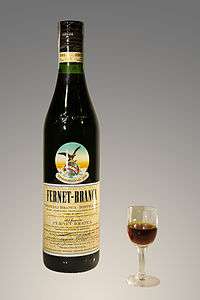Fernet-Branca
Fernet-Branca (Italian pronunciation: [ferˌnɛt ˈbraŋka]) is a brand of fernet, which is a style of amaro originating in Italy. Manufactured by Fratelli Branca and formulated in Milan in 1845, it is one the best known of Italian bitters.[1]
 | |
| Type | amaro bitter (fernet) |
|---|---|
| Manufacturer | Fratelli Branca Distillerie |
| Country of origin | Milan, Italy |
| Introduced | 1845 |
| Alcohol by volume | 39% |
| Flavour | Bitter |
Production history
Fernet-Branca was formulated in Milan in 1845 by self-taught herbalist Bernardino Branca. It was marketed as a cure for cholera, stomach ache, and nervous disorders. The brand soon gained popularity, leading to the founding of the Fratelli Branca Distillery. Fratelli Branca invested in extensive advertising campaigns including the creation of calendars with artworks from famous artists in 1886. The eagle-and-globe logo was designed in 1893.
In 1907, Fratelli Branca began exporting their fernet to Argentina. Eventually the drink became so popular there that Fratelli Branca established a distillery in 1925 in Buenos Aires.[2] The drink did not attain significant popularity as a beverage in the United States until after World War II, but a domestically made low-alcohol version was introduced a year after the end of prohibition and sold in pharmacies as a medicinal product.[3]
Formulation
Fernet-Branca has been produced according to the original recipe that has been handed down from generation to generation.[lower-alpha 1] The bitters are made from 27 herbs and other ingredients. The exact formula is a trade secret known only to the Fernet-Branca president, Niccolò Branca, who personally measures out the aromatics during the production process. It is known that the beverage contains aloe ferox (bitter aloe), gentian (a bittering agent), chamomile, angelica, quinine, chinese rhubarb, myrrh, peppermint, saffron.
Fernet-Branca has a higher ABV—39%—and lower sugar content than most other amari. Fernet-Branca is one of the few amari to be aged in a barrel for a full year.[8]
The manufacturer also offers a sweeter, mint-flavored liqueur, Branca Menta.
Consumption
.jpg)
Fernet-Branca is often consumed neat as a digestif, typically served in a cordial glass, or as a mixing component (usually supportive and not as the primary ingredient) in cocktails such as the "Toronto",[9] the "Fanciulli", and the more prolific "Hanky Panky".
In Argentina, Bolivia and Uruguay, fernet con coca—Fernet-Branca with Coca-Cola—is a popular drink.[10] The cocktail is so popular in Argentina that the country consumes more than 75% of all fernet produced globally.[11]
In the U.S., Fernet-Branca is branded as a tribal rite of passage drink for craft bartenders, and has been referred to as "The Bartender’s Handshake"[8].
In popular culture
- Alfred Pennyworth (played by Michael Caine) drinks Fernet-Branca in the 2012 film The Dark Knight Rises.[12]
- Bill Cosby, on his 1973 album Fat Albert, performed a comedic monologue about how, while in Florence, Italy, Fernet-Branca helped him recover from unknowingly ordering, and then intentionally eating, barbecued sparrow.
- On the podcast Harmontown, co-host Jeff Bryan Davis affection for Fernet-Branca is frequently used as a humorous device to show Davis's refined taste.
- In 2004, James Hamilton-Paterson published the novel Cooking with Fernet Branca.[13]
- A 2011 song by Equipto and Michael Mashall entitled "I Drink Fernet" is dedicated to Fernet-Branca.[14]
Notes & references
- After the Psychotropic Substances Act (United States) was passed in 1978, the recipe was changed in order to bring opiates down to legal levels.[4][5][6][7]
- Lichine, Alexis (1987). New Encyclopedia of Wines & Spirits (6th ed.). p. 233. ISBN 978-0304311248.
-
"Frateli Branca Destilerías - Institucional". 31 May 2020.
Con las migraciones italianas de fines del siglo XIX llegó Fernet Branca a la Argentina. Debido a su gran aceptación, la compañía decidió en 1925 que la empresa Hofer & C. de Buenos Aires -concesionaria exclusiva para la venta del famoso “amaro” italiano- elaborara la bebida a partir del extracto enviado desde la casa matriz italiana.
- Maier, Kathryn. "Ten Fascinating Facts About Fernet-Branca We Learned During Its 'Storied Sips' Book Tour". Culture Truip. Retrieved 5 June 2020.
- "An Amaro That Will Make History". 17 July 2017. Retrieved 30 May 2020.
- "Fernet-Branca: a brand history". The Spirits Business. 14 February 2017. Retrieved 12 April 2020.
- Cavalieri, Nate (7 December 2005). "The Myth of Fernet". SF Weekly. Archived from the original on 21 February 2007. Retrieved 11 April 2020.
- Curtis, Wayne (1 November 2008). "The Bitter Beginning". The Atlantic.
- "The Fuss About Fernet-Branca". Drink Spirits. 3 November 2013. Retrieved 28 April 2015.
- Flack, Derek (23 August 2017). "Toronto's namesake cocktail is the best drink you've never had". blogTO.
- Caro, Rebecca. "Argentinean Mixology: Fernet and Coke". From Argentina With Love. Retrieved 7 December 2016.
- Lahrichi, Kamilia (14 March 2017). "Argentina loves its Fernet, a bitter Italian liquor". CNN. Retrieved 16 June 2020.
- Along With the Dark Knight, Fernet Branca Also Rises The Drink Nation. Retrieved November 03, 2015.
- Drzal, Dawn (18 December 2015). "From a Tuscan Kitchen". The New York Times. New York, NY. Retrieved 3 November 2015.
- Christopher, Ross (21 June 2011). "Are Italian Digestifs the New Courvoisier? Check the Rap Dedicated to Fernet-Branca". Culture. Details Magazine. Retrieved 3 November 2015.